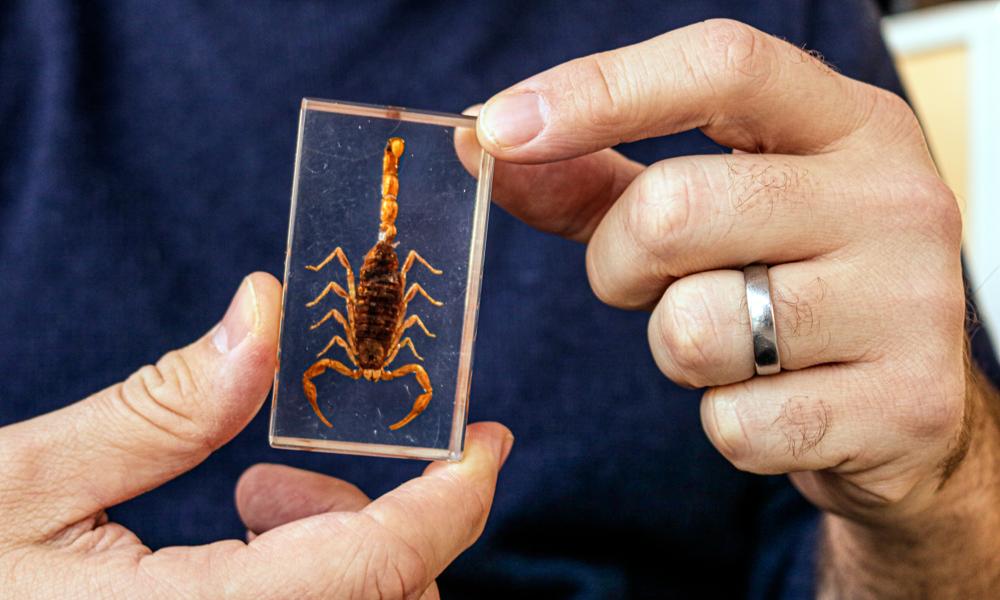There it is, on the desk, watching us: Leiurus quinquestriatus, known as the deathstalker or, in Swedish, the ‘death scorpion’.
“It’s a birthday present from one of my students, and we actually get the venom from that particular scorpion species,” says Jeroen Goos, Associate Professor, researcher and radioactivity specialist at the Department of Clinical Neuroscience at Karolinska Institutet in Stockholm.
AnnonsFortunately, this is a stuffed specimen encased in a plastic-like material. Jeroen Goos fiddles with the transparent cube and explains his research project, which focuses on developing strategies for delivering radiopharmaceuticals to the brain and killing brain tumour cells, primarily in children, with as little risk and side effects as possible.
Today, the primary treatment is open brain surgery to remove the tumour, but this is a complicated and risky procedure.
“We are trying to develop a minimally invasive approach, where we inject radioactively labelled tumour-seeking molecules that will find and bind to the cancer cells in the brain, which they will then irradiate and destroy from within. This means that only the tumour cells are destroyed, not the surrounding area.”
Annons
However, the molecules must pass through a major obstacle: the blood-brain barrier. It is made up of tightly packed capillary walls in the brain’s blood vessels that protect the brain tissue from foreign substances, thus also making it difficult for drugs to penetrate.
Jeroen Goos and his team are trying two different strategies to meet this challenge. One involves a peptide derived from scorpion venom, which has been found to have an exceptional ability to cross the blood-brain barrier.
“It was designed by nature to attack the nervous system, as this is how scorpions knock out their prey in order to eat it. The venom in its natural form is obviously not beneficial to humans, even though it is normally not fatal, but this peptide is harmless.”
AnnonsThe peptide has also been found to have an excellent ability to bind to tumour cells. As it does so, the tumour cell begins to ‘eat’ the peptide with its accompanying isotope, and it dies from the radioactivity.
In parallel with the ‘scorpion approach’, the research team is working on another strategy, where a bispecific antibody has been designed to perform two jobs: to cross the blood-brain barrier and to bind to tumour cells.
“If one method doesn’t work, we hope the other one does because we truly want to make this happen,” says Jeroen Goos.
The research team not only has to get the therapeutic radioactivity into the tumour cells but also ensure that the rest of the body does not receive excessive doses of radiation. To do so, they use so-called pre-targeting based on click chemistry, the same technology that won the 2022 Nobel Prize in Chemistry.
AnnonsThe first piece of the puzzle ‒ that is, the peptide or the bispecific antibody ‒ and the second, consisting of the radioactive substance, are injected separately from each other. The latter is designed to disappear from the body within a few hours ‒ unless it finds the first puzzle piece at the tumour and reacts chemically with it.

The research project is still at a relatively early stage. Studies in mice are currently ongoing, with some encouraging results, but much development work remains to be done.
What are you hoping to achieve with your research?
“That we can make this work clinically, in patients. That we can treat children with brain cancer by using injections instead of surgery and improve the survival rate and quality of life after the treatment. A more realistic scenario is that the method ‒ if we can make it work ‒ can be used when the tumour can’t be surgically removed or as a supplementary treatment when parts of a tumour remain after surgery. If we get that far, I will be delighted!”
AnnonsA more realistic scenario is that the method ‒ if we can make it work ‒ can be used when the tumour can’t be surgically removed
